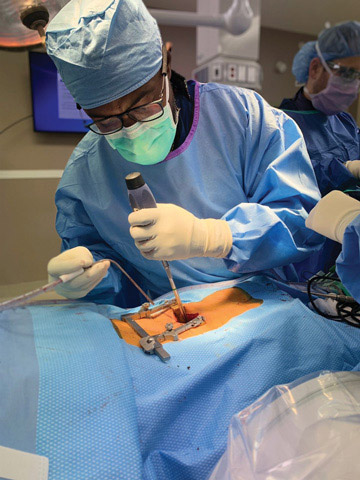Growth opportunities abound thanks to new techniques, better anesthesia and improved pain control.
 Lakeshore Bone & Joint Institute
Lakeshore Bone & Joint Institute
SAME-DAY SPINE Improved pain management protocols and surgical techniques are driving spine procedures to outpatient facilities.
Spine surgeries used to require a six-inch incision and a saber saw to cut through muscles. Patients lost a lot of blood and managing their post-op pain required several days of convalescence in a hospital.
Those days are gone. Surgical advances and new anesthesia treatments have made today's procedures shorter with less blood loss, a lower risk of complications and significantly milder pain levels.
"Minimally invasive spine is a movement over the past seven or eight years that is gaining momentum every year," says Alexander R. Vaccaro, MD, PhD, MBA, president of Rothman Orthopaedics in Philadelphia, which is planning a national expansion. "Patients, surgeons and payers prefer it. Everybody loves it, which is why spine surgery is the hottest topic in ambulatory surgical center circles today."
Today, minimally invasive surgeries allow patients who have undergone microdiscectomies, anterior cervical discectomy and fusions (ACDFs) and lumbar fusions to be safely discharged within 24 hours of their operations, says Dwight S. Tyndall, MD, FAAOS, a spine surgeon in the greater Chicago area. With appropriate anesthesia, effective pain control and a sound rehabilitation plan, Dr. Vaccaro estimates that two-thirds of all spine surgeries can be performed in an appropriately staffed ASC. Research shows that single- and two-level ACDFs are safe in an outpatient setting, as are some three-level ACDFs.
Improved patient selection criteria and pre-op optimization have also been factors in the expansion of same-day spine procedures. Rothman employees, for example, use artificial intelligence to analyze patients' height, weight, comorbidities, age, prior surgeries, smoking history and other characteristics to see if they are appropriate candidates for outpatient ACDFs.
Dr. Tyndall won't perform an outpatient ACDF on an otherwise healthy 45-year-old patient if their BMI is 40 or above. "It makes even minimally invasive approaches much harder simply because there's so much more tissue to work through," he says. "That means it's going to be a longer procedure and therefore there will be more risks for complications, so it's better to work with most of these patients in an inpatient environment." Lumbar solutions, however, can be safely performed in outpatient settings on patients with BMIs as high as 50, according to Dr. Tyndall.
Transitioning from traditional general anesthesia to IV anesthetics allows patients to wake up without feeling groggy, which hastens recoveries and makes for fast and safe discharges, says Dr. Tyndall. He points out that replacing most opioids with combinations that include IV acetaminophen, antibiotics, gabapentin, pregabalin and steroids has helped make outpatient spine procedures a reality as well.
"Hospitals should be tertiary and quaternary care centers where surgeons perform complex cases such as revision hip arthroplasty, scoliosis surgery, trauma cases, and tumor and infection procedures," explains Dr. Vaccaro. "The trend for elective cases to be in an outpatient setting needs to continue."
Dr. Tyndall agrees, saying he's grateful to provide patients with relief from chronic pain while gaining access with incisions one-third the size he used only 10 years ago. "I can't tell you the last time I used a saw saber or the last time I actually had to order labs after surgery to check a patient's blood count," he says. "It's just not necessary anymore because the procedures have become so miniaturized that the amount of blood loss is miniscule."
.svg?sfvrsn=be606e78_3)

.svg?sfvrsn=56b2f850_5)